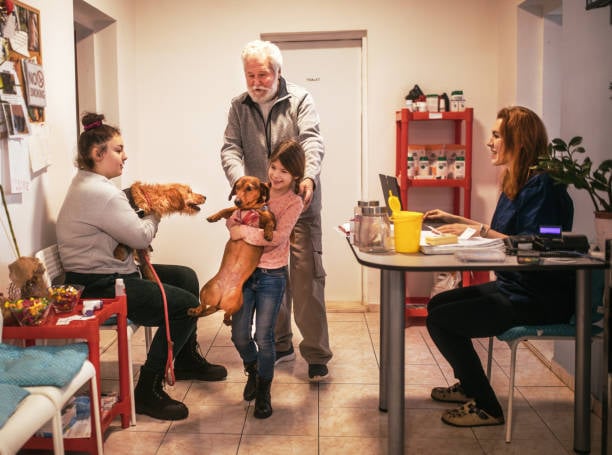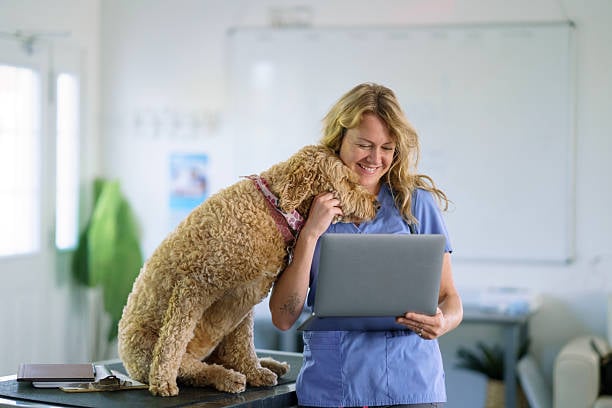For many dog trainers, the work begins well before the leash is clipped on. While teaching good manners and building trust with pets is the rewarding part of the job, managing the check-in process at a busy dog training facility can often feel like herding cats—or in this case, very excited pups on a specialized platform.
Whether you’re running group classes, private lessons, or behavioral boot camps, the check-in flow sets the tone for the entire training experience. A smooth start means trainers can focus on what they do best: training dogs. A chaotic one? That’s when things can quickly go off leash.
Fortunately, modern tools like Gingr’s dog training platform are helping dog training businesses of all sizes simplify the process. The software makes the check-in process easy for trainers and staff, allowing them to save time and reduce errors. Trainers can also connect with other tools or team members through the platform to streamline operations and improve communication. When juggling a phone, leash, appointment book, and clicker all in the same hand just isn't realistic, dog trainer software can really save the day.
A Day in the Life at Your Bustling Dog Training Business
Dog trainers know the workday begins well before the first paw walks through the door. There’s coffee to be brewed, email to check, and—if you’re lucky—a moment to review the day’s training schedule. Meeting the needs of different clients and dogs is always a priority, ensuring each session is tailored to help both dogs and owners succeed. But the real rhythm of the job starts with the dogs. And on a typical day, the pace doesn’t let up.
7:30 a.m. – The first clients begin to arrive. Some are new faces. Others are familiar and returning for ongoing sessions or evaluations. Without a digital system in place, this part of the day can be chaotic. You’re juggling paper intake forms, trying to remember behavioral quirks from memory, and rushing to prep the training room—all before the caffeine has had a chance to kick in.
8 a.m. – Group class kicks off. Group classes help dogs learn new skills and build confidence. Teaching basic commands like 'sit,' 'stay,' and 'come' is a core part of the session. Physical contact reinforces positive behaviors, and recall is practiced by teaching dogs to come when called. Dogs are trained to maintain position on a training platform or board, which helps clarify the difference between staying on the ground versus a designated spot. But you’re teaching five dogs with wildly different personalities. One’s afraid of new people. Another can’t sit still. You wish you’d had time to review their pet profiles beforehand, but there wasn’t a spare moment during check-in.
10 a.m. – Private sessions begin. A young lab mix is working on impulse control. A reactive shepherd is starting leash work. As the handler, you lead the dog through each exercise, guiding them to success. Physical contact reinforces correct actions, and recall exercises focus on coming when called. Maintaining position on a board is emphasized, helping the dog understand the distinction between the ground and the training platform. It's focus time.
12:30 p.m. – Lunch? Kind of. You grab a bite while replying to text messages from pet parents asking how their dog is doing. You meant to send an update, but the morning flew by. You jot down a reminder to send report cards later.
2 p.m. – Another round of private training. One client added a socialization session at drop-off, but your front desk didn’t catch it. Now you’re adjusting the schedule mid-stream. It’s frustrating, but you make it work. There are options available for different training sessions, allowing you to meet the unique needs of each client and dog.
4 p.m. – Check-out begins. Dogs are excited. Parents are asking for feedback. You’re trying to remember who worked on what, what progress was made, and what to recommend next. Without centralized notes or history, you rely on memory. Reviewing a collection of training videos or resources can help reinforce techniques and provide additional support for both trainers and clients... when time allows.
6 p.m. – The last dog goes home. You’re mentally drained but still have admin work to do—logging notes, updating client records, and answering emails. It’s not the glamorous part, but it’s an important apsect of the job.
Now tell us: Where do you fit in personalized, one-on-one check-ins with multiple pickups in your care?
It’s a fair question—and one every dog trainer has probably asked themselves after a long day: “Did I spend enough time actually connecting with each dog and their parent?”
Between managing back-to-back sessions, coordinating with staff, and handling a dozen micro-decisions before noon, that personal moment of checking in—where you truly hear the pet parent’s concerns or celebrate a dog’s small victory—a commitment that often falls by the wayside.
The challenge isn’t a lack of passion. It’s a lack of breathing room.

Dedicating specific time or resources for these one-on-one check-ins ensures that each client receives the attention they deserve, and trainers can provide the dedicated support needed for both pets and their owners during these interactions. When the basics of your operation (check-ins, records, scheduling, updates) are disorganized or manual, they eat up the small windows of time you might have used for that deeper client communication. Those personal touchpoints are where trust is built, clients feel seen, and loyalty grows!
Imagine having five extra minutes with each pet parent, because you weren’t buried in intake forms or chasing down missing details. That space isn’t just a luxury. It’s a necessity for pet-care professionals who want to do more than teach obedience. It’s how you build lasting relationships in a business built on trust. These moments also help trainers better understand client needs and concerns, leading to more effective communication and results.
So, if you’re wondering where to fit in that one-on-one moment… maybe it’s not about finding more hours. Maybe it’s about freeing up the ones you already have.
Check-In Chaos: Common Struggles Trainers Face
If you’re running a dog training business, you already know that check-in can be the most unpredictable part of your day. Here’s why it’s often the source of stress:
1. Too Much Information, Too Little Time
Every dog is unique, and that’s especially true in training. From temperament issues and health concerns to recent behavior regressions or new goals, there’s a lot to document. Gathering that information on the fly, while juggling multiple arrivals, often leads to missed details.
2. Inconsistent Client Experiences
Without a standardized system, check-in varies wildly depending on who’s at the front desk, how much time they have, or which forms they remember to ask for. Unclear instructions or missing paperwork can leave clients confused or frustrated, especially when pricing isn’t communicated clearly. Inconsistency can make clients feel uncertain about the value they’re getting and may even deter them from returning. Chaotic check-ins not only create stress for your team but can also lead to negative reviews from clients who are frustrated by the experience.
3. Overbooked Schedules and No-Shows
Training classes are often scheduled tightly, and a late start can throw off your entire day. If pet parents forget to show or bring their dog without the proper paperwork, it can impact our daily targets. It can leave your trainers scrambling to fill time or reschedule. Missed appointments, double bookings, or inefficient processes mean you’re not just losing time—you’re also losing money that could be earned from additional sessions or new clients.
4. Disconnected Tools
Some trainers manage bookings in one app, store pet records in another, and keep behavior notes in a paper binder. Not only is that inefficient—it’s a recipe for important information getting lost in the shuffle. For trainers who often juggle multiple locations or home-based sessions, the lack of integration across tools means time lost to busywork instead of spent on what really matters: training!
What the Right Dog Training Platform Can Do For You
Managing a smooth check-in is one of the most underrated parts of running a dog training business. When the front desk is disorganized, it doesn’t just delay your day—it can create tension for pets and pet parents before training even begins.
Not every dog training business looks the same, and not every check-in should either. From solo trainers handling private clients to multi-trainer facilities with group sessions, the right check-in setup must match your workflow, not force you to change it.
The right platform offers support for both solo trainers and multi-trainer facilities, ensuring the flexibility you need. Trainers can customize their check-in workflow to best suit their business model.
Gingr offers features built for busy dog-care businesses to streamline the check-in process so they have more time with pups. Here are a few ways to simplify your check-in time with our pet-care software and dog training platform:
Quick Check-In for Busy Days
When several dogs are scheduled back-to-back for group class, time is tight. Quick Check-In allows your team to mark pets as arrived with just a click or two—ideal for saving time during the morning rush or when clients are all arriving within a narrow window. You won’t need to sift through individual files or spreadsheets; it’s all right there.
Expected Today Section
This dashboard feature gives trainers a real-time view of which pets are scheduled to arrive that day, eliminating guesswork. When clients walk in, your team simply confirms their arrival. If you’ve set up custom questions—like “Has your dog had breakfast?” or “Any changes in behavior since last session?”—staff can check or update those answers on the spot, ensuring records stay accurate.
Training-Focused Pet Profiles
Each pet’s profile includes their training history, health alerts, behavior flags, and any special notes. This means trainers walking into a session know exactly what to expect, whether it's a dog working on reactivity, leash manners, or basic obedience. Pet profiles act as your go-to hub for all client context, helping ensure safety and consistency in training.
Icons For Important Info at a Glance
Visual cues help staff stay on top of details without needing to dig through notes. Icons like the green checkmark for completed PreCheck, a gold star for first-time clients, or alert symbols for behavioral notes give your team critical information at a glance. It's a subtle but effective way to reduce miscommunication and set trainers up for success.
Rather than offering a one-size-fits-all solution, these tools let you shape check-ins to fit your business. Whether you’re scaling up your facility or fine-tuning how you work with clients, the right features help you stay responsive and stay focused on your mission to train dogs well.

Gingr PreCheck: Training for a Smoother Start
A pre-arrival workflow can make all the difference. With Gingr PreCheck, dog trainers can invite pet parents to complete important information about their dog’s upcoming session ahead of time to access all relevant details. Clients can also learn about the benefits of using PreCheck, making the process smoother and more transparent. This includes everything from dietary needs and medications to what training tools they bring or behavioral concerns to remember.
Trainers can also provide a collection of training videos or materials through PreCheck, giving pet parents valuable resources before the session. For trainers, having this context before a dog even walks through the door helps avoid confusion and allows for better planning.
Timely Notifications
No more last-minute reminders about harnesses, treats, or toys. When pet parents can confirm all of this in advance, your staff can prepare accordingly. It’s also easier to spot inconsistencies, like a dog showing up for advanced training without completing an earlier level.
Add-On Opportunities
Rather than having to pitch extras face-to-face at drop-off, trainers can make optional services available in the PreCheck form. Whether it’s a one-on-one focus session, enrichment games, or video updates, clients can add what they want at their own pace. It’s not just about boosting revenue—it’s about offering clear, convenient choices.
Zen-Like Lobbies
When the front desk isn’t fielding forms, questions, or corrections, the whole environment feels calmer. This is especially important when working with dogs who are easily overstimulated. A peaceful lobby benefits everyone, from new pups learning to focus to experienced dogs jumping into their next challenge.
Curbside & Mobile Convenience
For trainers offering mobile services or drive-up classes, having a paper-free system helps keep things efficient. Pet parents can check in from their phones while your team prepares for the session. Whether you’re operating from a facility or a field, this flexibility supports a smoother workflow.
Gingr PreCheck isn’t about replacing personal interaction—it’s about giving trainers and pet parents a better foundation for it, specifically designed to enhance communication. With the essentials handled in advance, conversations can be more focused, thoughtful, and productive.

Improving Collaboration and Client Engagement
In dog training, success is rarely a solo act. The most effective dog training businesses thrive on strong teamwork and meaningful client engagement—two pillars that are easier to achieve with the right training platform in place.
A modern dog training platform is designed to bring trainers, pet owners, and staff together, making collaboration seamless and communication effortless. With advanced features tailored for dog trainers, your team can easily share knowledge, training methods, and best practices, ensuring every dog benefits from the collective expertise of your business. Whether you’re teaching basic obedience or tackling complex behaviors, having a unified system means trainers can quickly access pet profiles, review progress, and coordinate strategies for each dog.
For pet parents, this level of organization translates into a more personalized experience. Trainers can deliver tailored training programs that address each dog’s unique needs, track milestones like mastering “sit” or improving leash manners, and keep owners updated with videos, class summaries, and progress reports. Communication tools ensure everyone stays on the same page, making it easier to set goals, share feedback, and celebrate every success, big or small.
Beyond training sessions and easier check-ins, a comprehensive platform helps dog training businesses manage appointments, client interactions, and payments all in one place. This streamlines daily operations and provides valuable insights into what’s working and where there’s room to improve. By tracking behaviors, attendance, and outcomes, trainers can make data-driven decisions that enhance their services and help more dogs reach their full potential.Access to a library of resources—like expert-led classes, instructional videos, and up-to-date training techniques—empowers trainers to continuously refine their skills and stay ahead of industry trends. This commitment to learning and improvement sets your business apart, ensuring you always offer the best possible service to your clients and their pets.
Ultimately, prioritizing teamwork and client engagement isn’t just good for business—it’s essential for building trust, delivering results, and fostering lasting relationships with pet owners. When your team is connected, your clients feel supported, — from check-in, to every update, checkout, and beyond. When every dog gets the attention it deserves, your dog training business is positioned to grow, improve, and make a real difference in the lives of pets and their families.
Bonus Tools That Keep Things Running Smoothly
Gingr also offers additional functionality that enhances check-in without overwhelming your staff:
- Barcode Key Tags: Use barcode scanners just like a gym or grocery store for ultra-fast, touchless check-ins.
- Animal Profile Check-In: Quickly check in pets from their individual profiles while reviewing any special notes or training history.
- Integrated Communication: Use SMS or email to confirm training sessions or notify pet parents when their dog is ready to go home.
- Connect with Other Tools: Seamlessly connect Gingr with other business tools or platforms to streamline operations and improve efficiency.
Of course, Gingr’s dashboard gives trainers and owners a bird's-eye view of the day, making scheduling, adjustments, and staff collaboration a breeze. Trainers can directly assign resources or adjust schedules, ensuring smooth and efficient management.
Check-In Shouldn’t Be a Chore
For dog trainers, first impressions matter. A chaotic check-in can rattle a nervous pet or frustrate a first-time client. A seamless one builds confidence and trust, and lays the foundation for long-term loyalty.
Here’s what a streamlined check-in unlocks:
- More time for actual training: Less admin work = more paws on the floor.
- Stronger pet-parent communication: Automated confirmations, reminders, and report cards show clients you care. Better check-ins also help trainers understand client and pet needs more effectively.
- Greater consistency across staff: Standardized workflows mean no more “Did we ask about X?” moments.
- Opportunities to impress: When drop-off is fast and friction-free, clients are more likely to return and recommend your services to others.
- Ongoing support for trainers and clients: Streamlined check-ins support both trainers and clients throughout the training process, making it easier to track progress and address any challenges.

Why Dog Trainers Choose Gingr
Whether you’re just starting out or growing your facility into a multi-location enterprise, Gingr scales with you. Small businesses love the ease and automation; larger operations appreciate the customization and analytics. Trainers also benefit from dedicated support and resources, ensuring personalized assistance whenever needed.
With Gingr, dog trainers can:
- Streamline their workflow with fewer tools and more automation.
- Reduce front desk chaos using Gingr PreCheck and custom workflows.
- Build customer loyalty through better communication and more reliable service.
- Increase revenue with smart upsells and frictionless payments.
- Save time and money by reducing manual tasks and optimizing operations.
Your focus should be on training, not troubleshooting. By streamlining check-in with Gingr’s simple or advanced features, your dog training business can start every session confidently, clearly, and calmly.
So go ahead—ditch the paperwork, cut the chaos, and greet every client with a smile. When check-in is seamless, everything else falls into place. Get a demo of Gingr today!
Subscribe to the Gingr Blog







